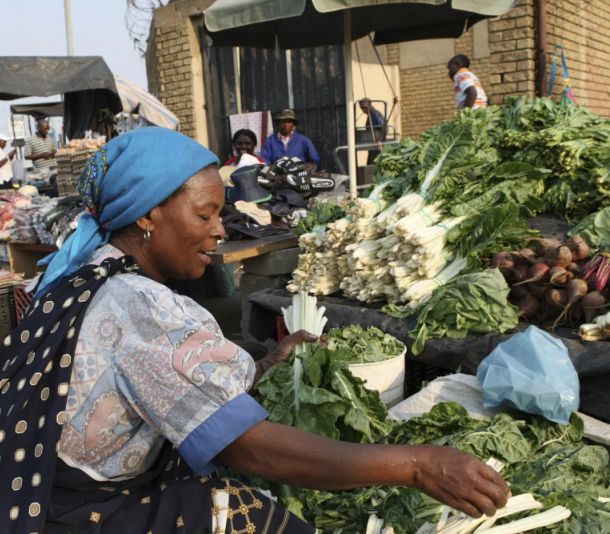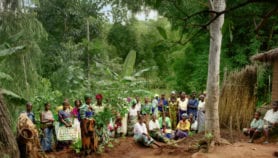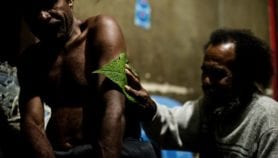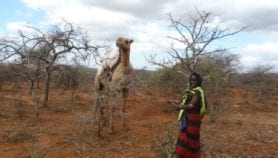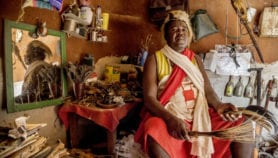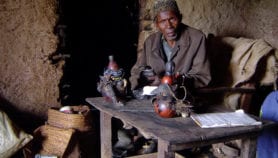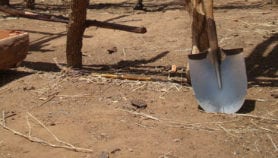By:莎拉·怀尔德
寄给朋友
您在此页面上提供的详细信息将不会用于发送未经请求的电子邮件,也不会出售给第三方。请参阅隐私政策。
莫洛戈植物(Morogo)植物多汁的绿色叶子在南部非洲周围的杂草像杂草一样生长,在炎热的干燥气候下蓬勃发展。
The plants are gathered by women from the wild or grown by subsistence farmers, and are a staple food in rural communities, supplementing a starch-rich and nutrient-poor diet. But morogo is now finding its way onto supermarket shelves in the form of Maggi 2-Minute noodles, a brand produced by Nestlé.
在明亮的黄色和方便食品包装中,找到了几代人的非洲土著知识,这很奇怪,但是新产品是该国土著知识商业化的最新尝试。
“We know our grandparents said this [morogo] is good for us, and [here is] the science to back it up.”
南非科学与工业研究委员会(CSIR)Tshidi Moroka
绿叶蔬菜,一种Amaranthuswhich is called wild African spinach in English and has other names according to South African languages: imifino in isiZulu and isiXhosa, morogo in Sesotho and isiPedi and muhuro in Tshivenda, are found abundantly in southern Africa. These nutritious plants could be a way to address malnutrition and食品安全因为它们具有相对较高的维生素和矿物质含量。
However, there has been a slow uptake of the country's土著知识, despite numerous government initiatives to commercialise this local know-how in order to create new products and industries.
公共伙伴关系成功
新产品上个月(10月8日)推出,可以在Shoprite(位于南非的零售和快餐公司Shoprite)中找到,这是公私合作伙伴关系的结果,希望能看到更多该国的土著知识商业化。
Tshidi Moroka,合同research and development南非科学与工业研究委员会(CSIR)的成果经理说:“我们知道我们的祖父母说,这对我们有好处,[这是]科学来支持它。”
该项目 - 导致Maggi 2分钟与Real Morogo的面条 - 是一项涉及CSIR的合作农业雀巢南非和科学系研究委员会和技术, South Africa, dating back to 2012.
在微波炉中制备后,在水状绿色酱汁中搭配摩洛哥调味蒸汽的面条具有咸,独特的菠菜状味道。
“Farming morogo is something very new [to the farmers]. They know it as a wild weed.”
Anold Derembwe, TechnoServe South Africa
南非农业研究委员会的土著蔬菜高级研究员Melake Fessehazion解释了为什么人们喜欢该产品的人:“雀巢进行了市场调查,尤其是在农村地区,他们发现人们说:'我们想吃这件事。,但是我们在哪里可以得到它?我认为人们很感兴趣,因为这是文化的一部分,但他们不知道如何获得文化。”
Morogo背后的科学
研究委员会评估了种植农作物的经济学方面。“他们以前从未商业化过商业化,”费斯海齐翁说。“ [我们必须找出]最佳收益率是什么,并看到这些农作物是否有利可图……它们就像其他任何蔬菜一样 - 您可以从中赚钱。”
This is what Okakeng Lebetle is trying to do. He is a member of a four-farmer cooperative in the country’s North West, growing morogo for the noodles. Their five-hectare farm just outside of Brits — a large, industrial town near Pretoria — is one of two sites producing the leafy green vegetable commercially. The other, an eight-hectare farm, is in the Eastern Cape and run by a different cooperative of emerging农民.
当被问及他是否吃Morogo时,Lebetle是Bakwena ba Mogopa土地索赔的受益人,就在英国人外面,他在种植农作物的情况下说:“我的祖母确实如此。我用这些东西长大了。”
“这很容易生长。它只是一种杂草,[因此]它本身就会生长。您必须关注土壤质量和控制昆虫,但除此之外,这不是问题。”他解释说。
但是Lebetle补充说,主要关注的是农作物的市场似乎不清楚。
At the moment, this farmer-market-consumer relationship is facilitated by the high-level Nestle-政府合作伙伴关系,并由非营利的Technoserve实施。
“农业莫罗戈(Morogo)对农民来说是非常新的东西。他们知道这是一种野生杂草。在南非和津巴布韦,它从未被商业化……从我们看到的结果来看,每个人都像“哇”,这起作用了。”他说。
The innovative food product is labelled as a “limited edition,” thus allowing stakeholders to gauge the success of the trial phase.
CSIR的Moroka说,但是Morogo只是该伙伴关系正在探索的植物之一。“南非的生物多样性是我们的竞争优势。为什么我们不使用这个机会?”她问。
这件作品是由Scidev.net的撒哈拉以南非洲英语和南非的邮件与卫报(Mail&Guardian)共同制作的,这是科学新闻业能力建设计划的一部分,由惠康信托基金会资助
有关土著的更多信息
消息
研究评估植物在抗疟疾疗法中的使用
[COTONOU, BENIN] Traditional healers in Benin possess sophisticated knowledge regarding the treatment ...
29/01/13


